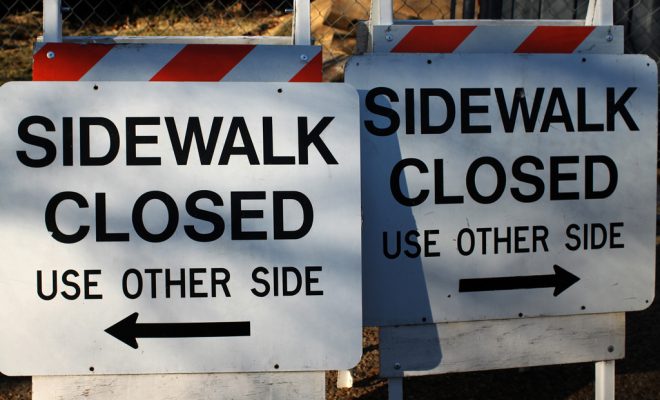 Image courtesy of Mr.TinDC; License: (CC BY-ND 2.0)
Image courtesy of Mr.TinDC; License: (CC BY-ND 2.0)
Politics
What Does a “Government Shutdown” Entail?
It’s a classic concern in Washington, a seemingly annual potential: a government shutdown. Now, talk of a government shutdown looms over the Trump Administration and the 115th U.S. Congress. This week, Congressional leaders are scheduled to send President Donald Trump a spending bill, but one that notably lacks many of his most inflammatory campaign promises. It doesn’t contain any money for Trump’s border wall and it doesn’t defund Planned Parenthood, among other unfulfilled promises. So, if Trump vetoes the bill, the federal government won’t have the money to function and it will trigger a government shutdown. But what actually is a government shutdown? What does it mean? How often does it happen? Read on to find out.
What is a “Government Shutdown?”
Essentially a “government shutdown” happens when, for whatever reason, a spending bill is not passed. There are multiple ways this could happen. For example, the Republicans and Democrats in Congress may not be able to agree on what measures should be included. Or, the president could veto the bill. But either way, it means that federal agencies don’t have the ability to spend money–meaning they can’t pay their employees or carry out a large chunk of their tasks. That’s deemed a “shutdown.”
Is there anything Congress can do to avoid a shutdown?
Well, obviously passing a spending bill (which is really a collection of appropriations bills in an omnibus) is the optimal course of action. But that’s not the only option, because of course, various factions in the government disagree far more often than the government actually shuts down. That’s because Congress has the ability to pass something called a “continuing resolution”–a quick stopgap measure that gives them more time to figure out the spending bill. A continuing resolution is intended to fund the government at current levels until a permanent solution is figured out.
There’s also a combined continuing resolution/omnibus solution, which would fund certain, mostly uncontroversial agencies, while also temporarily funding the controversial issues. This measure, which is called a “CRomnibus,” would allow Congress to further debate on the controversial issues, but not wrap up the rest of the agencies’ and government’s funding as well.
When has the government shut down in the past?
It actually happens relatively frequently. Since 1976, which was the first year that the budgeting system as it now stands was implemented, the government has shut down–partially or fully–18 times. Many of those shutdowns were incredibly quick and didn’t really affect anything, others were longer and more complicated. Note that many of these cases include multiple moving parts, but here are the basic gists of what stopped at least some of the cogs in the federal government from working:
- There was a shutdown for 10 days in 1976 during President Gerald Ford’s presidency. He vetoed a spending bill passed by a Democratic Congress, claiming that the spending for the Departments of Labor and Health, Education, and Welfare wasn’t reigned in enough.
- The government shut down three times during President Jimmy Carter’s presidency over the abortion debate alone. The shutdowns, which all occurred in 1977, were 12 days, eight days, and eight days respectively. The House wanted to continue to prohibit Medicaid funding from going to abortions; the Senate wanted to loosen the restrictions to include more exceptions.
- In 1978, also during Carter’s presidency, there was an 18-day shutdown when Carter vetoed part of a defense bill, claiming that funding for a nuclear-powered aircraft carrier was wasteful, among other issues.
- There was another shutdown during the Carter presidency in 1979, for 11 days, again related to abortion. The Senate refused to let the House give itself a pay increase without making federal abortion funding restrictions looser.
- In 1981, during President Ronald Reagan’s time in office, Reagan vetoed the spending bill after it fell $2 billion short of the cuts he wanted to make, sparking a two-day shutdown.
- The next year, still during Reagan’s presidency, there was a one-day shutdown, largely just because the House and Senate didn’t pass a spending bill in time.
- Again in 1982, Reagan threatened to veto a spending bill that set aside money for job creation, while neglecting to fund a defense program his administration saw as a priority. This led to a three-day shutdown.
- In 1983, the House passed a bill that gave more money to education, but cut foreign affairs spending and defense spending. Reagan didn’t like any of that. The resulting debate led to another three-day shutdown.
- In 1984, there was another short shutdown of two days, again because Congress wanted to fund (and to not fund) certain provisions against Reagan’s wishes, including a water projects package and civil rights measure. That led to another one-day shutdown when Congress and the White House failed to get everything together after a three-day extension.
- In 1986, there was a one-day shutdown when, once again, the Democrat-controlled House and Republican President Reagan disagreed over provisions in a funding bill.
- The last shutdown of Reagan’s presidency occurred for a day in 1987 when the president and the Democrats in Congress couldn’t agree on whether or not to fund the Nicaraguan “Contra” militants.
- There was a three-day shutdown in 1990 under President George H.W. Bush. Bush vetoed a measure that didn’t contain a deficit reduction plan.
- In 1995 there was a five-day shutdown, when President Bill Clinton vetoed a continuing resolution by the Republicans, who controlled Congress at the time. It had plenty of things he didn’t want in it, including raising Medicare premiums.
- From December 1995 to January 1996, there was a 21-day shutdown that again pitted Clinton against the then-House Speaker Newt Gingrich. Much of this shutdown involved semantics–Clinton was using Office of Management and Budget numbers to balance his budget, while Congress insisted he use the Congressional Budget Office’s numbers.
- The most recent government shutdown, in 2013, under President Barack Obama, lasted 16 days. Obamacare was the crux of the issue–the Republican-controlled House didn’t want to fund the bill, the Democrat-controlled Senate did.
What Actually Happens During a Shutdown?
Much of what happens during a government shutdown is dictated by the Antideficiency Act, a law originally enacted in 1884 and amended in 1950. According to Andrew Cohen of the Atlantic it is:
a collection of statutory and administrative provisions, really–that forbid federal officials from entering into financial obligations for which they do not have funding, like paying the salaries of their employees or buying the things they need to run the government. It’s also the law that wisely permits certain ‘essential’ government functions–like the military and the courts, for example–to keep operating even in the absence of authorized legislative funding.
So, one of the most notable effects of a government shutdown is on federal government employees. Essentially, government workers are split into a few different groups–those who are “essential” to keep daily life in the United States functioning, and those who aren’t. Those who aren’t include people who operate our national parks and large chunks of lower and mid-level staff at agencies and offices. They are furloughed, without pay, until whenever the government shutdown ends. Workers who stay on probably don’t get their pay on time. And a common point of contention is that members of Congress are still paid, even if there is a shutdown. It was estimated by Standard & Poor’s that the 2013 shutdown cost the economy approximately $24 billion.
Other effects of a shutdown can include delayed Social Security payments, no processing of travel documents like new passports, no processing of applications for things like Medicare, research for certain agencies like the CDC, and certain types of federal loans end up frozen. However, the TSA, Post Office, and active military are all certain to continue functioning.
Of course, some areas are more affected than others. Washington D.C., as a city that is in many ways controlled by the federal government, is pretty hard hit. Check out this video from the New York Times to learn more:
Conclusion
A “government shutdown” sounds quite a bit scarier than it actually is. It doesn’t signal anarchy, or the apocalypse, but rather a temporary (but certainly annoying) halt to some of our government’s day-to-day functions. That being said, it’s not great for those who are particularly affected–like the hundreds of thousands of workers who suddenly have to go for an indeterminate period without pay. It costs the economy quite a bit of money. And it disrupts an already tumultuous funding process for the federal government. It’s unclear when the next shutdown will be, but at this point it seems like it’s become a regular factor in Washington.








Comments